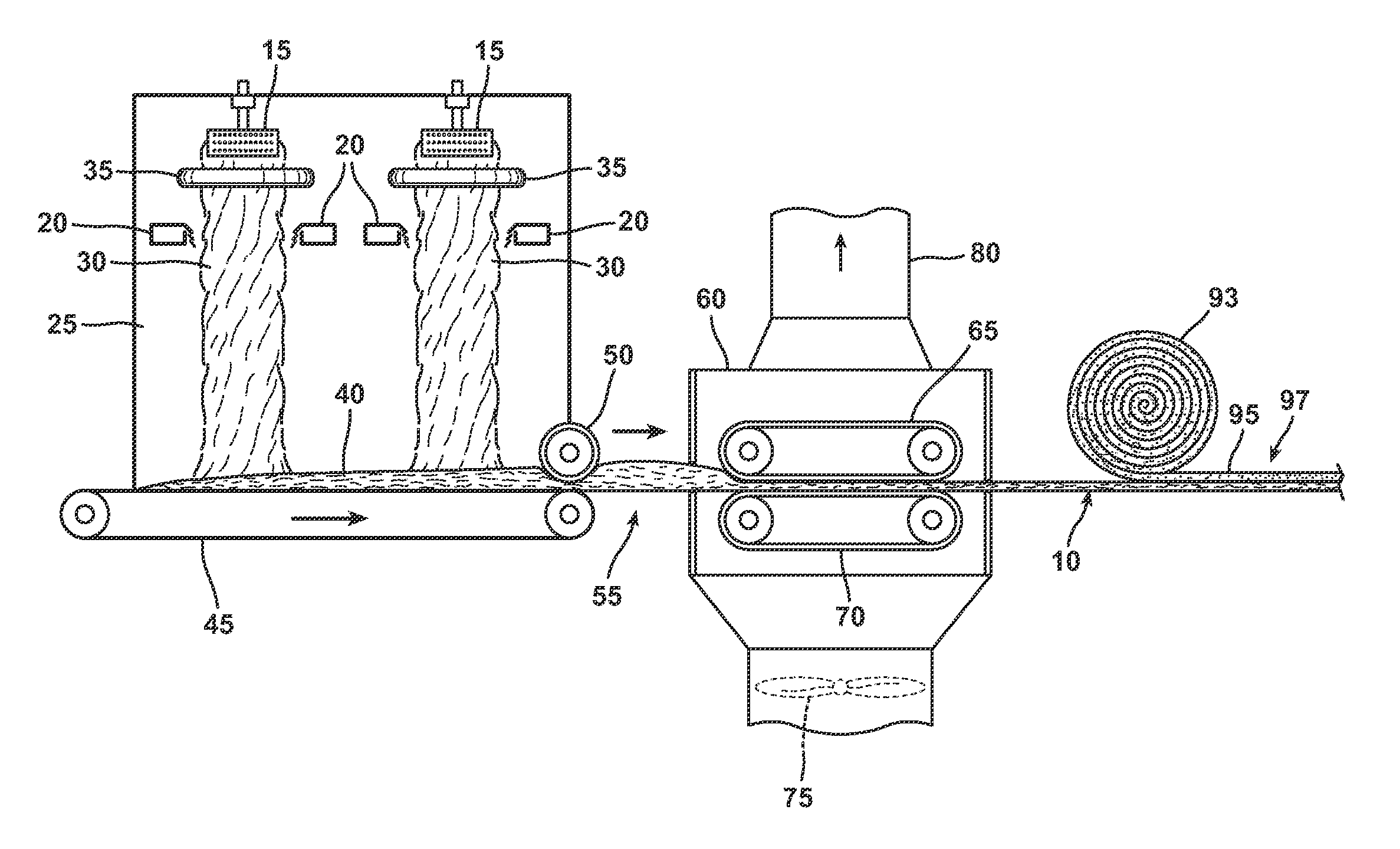Bio-based binders for insulation and non-woven mats
a bio-based, non-woven mat technology, applied in the direction of synthetic resin layered products, textiles and papermaking, woodworking apparatus, etc., can solve the problems of unstable urea-extended resoles, ammonia is not a particularly desirable alternative, throat and nose irritation of workers, etc., to save time and money, the effect of being convenient to us
- Summary
- Abstract
- Description
- Claims
- Application Information
AI Technical Summary
Benefits of technology
Problems solved by technology
Method used
Image
Examples
example 1
[0090]The binder formulations set forth in Table 4 were utilized to form handsheets in the manner described in detail below. The nonwoven fiberglass handsheets were dried and cured for three minutes at 400° F. The tensile strength, the Loss on Ignition (LOI), and the tensile strength divided by the LOI (tensile strength / LOI) for each sample was determined under ambient and steam conditions. The tensile strength was measured using Instron. The loss on ignition (LOI) of the reinforcing fibers is the reduction in weight experienced by the fibers after heating them to a temperature sufficient to burn or pyrolyze the organic size from the fibers. The loss on ignition was measured according to the procedure set forth in TAPPI T-1013 OM06, Loss on Ignition of Fiberglass Mats (2006). To place the handsheet in a steam environment, the handsheets were placed in an autoclave at 240° F. at a pressure between 400 and 500 psi for 30 minutes.
[0091]The handsheets were made according to the followin...
example 2
[0096]The binder formulations set forth in Table 6 were utilized to form handsheets according to the procedure set forth in Example 1. The nonwoven fiberglass handsheets were dried and cured for three minutes at 400° F. The tensile strength, the loss on ignition (LOI), and the tensile strength divided by the LOT (tensile strength / LOI) for each sample was determined under ambient and steam conditions. The steam conditions were identical to that set forth in Example 1. In addition, the loss on ignition and tensile strength of each the samples were measured according to the procedures described in Example 1. The results are set forth in Table 7. It is to be noted that the weights in Table 6 are expressed in grams (g).
[0097]
TABLE 6Sample 1Sample 3Sample 410% Citric20% Citric20% CitricAcidSample 2AcidAcidComponent5% SHPControl5% SHP5% SHPMaltodextrin79.9(DE 11.0)Maltodextrin79.9(DE 18.0)Maltodextrin89.8(DE 7.5)gamma-13.713.713.713.7aminopropyl-trihydroxy-silane (1.24%solution)Citric Acid...
example 3
[0100]The binder formulations set forth in Table 8 were utilized to form handsheets according to the procedure set forth in Example 1. The nonwoven fiberglass handsheets were dried and cured for three minutes at 400° F. The tensile strength, the LOI, and the tensile strength / LOI for each sample were determined under ambient and steam conditions. The steam conditions were identical to that set forth in Example 1. In addition, the loss on ignition and tensile strength of each the samples were measured according to the procedures described in Example 1. The results are set forth in Table 9. It is to be noted that the weights in Table 8 are expressed in grams (g).
[0101]
TABLE 8Sample 2Sample 570:30Sample 3Sample 470:30Sample 1MD-CA70:3070:30MD-CA70:30w / 5% SHPMD-CAMD-CAw / 3%MD-CAand 10%w / 4%w / 5%Li-Componentw / 5% SHPH3PO4H3PO2AlCl3CarboxylateMaltodextrin45.142.646.045.152.0(DE 11.0)Citric Acid19.314.219.219.323.3gamma-10.211.210.310.211.5aminopropyl-trihydroxy-silane (1.24%solution)Catalyst4....
PUM
| Property | Measurement | Unit |
|---|---|---|
| temperatures | aaaaa | aaaaa |
| diameter | aaaaa | aaaaa |
| diameter | aaaaa | aaaaa |
Abstract
Description
Claims
Application Information
 Login to View More
Login to View More - R&D
- Intellectual Property
- Life Sciences
- Materials
- Tech Scout
- Unparalleled Data Quality
- Higher Quality Content
- 60% Fewer Hallucinations
Browse by: Latest US Patents, China's latest patents, Technical Efficacy Thesaurus, Application Domain, Technology Topic, Popular Technical Reports.
© 2025 PatSnap. All rights reserved.Legal|Privacy policy|Modern Slavery Act Transparency Statement|Sitemap|About US| Contact US: help@patsnap.com



